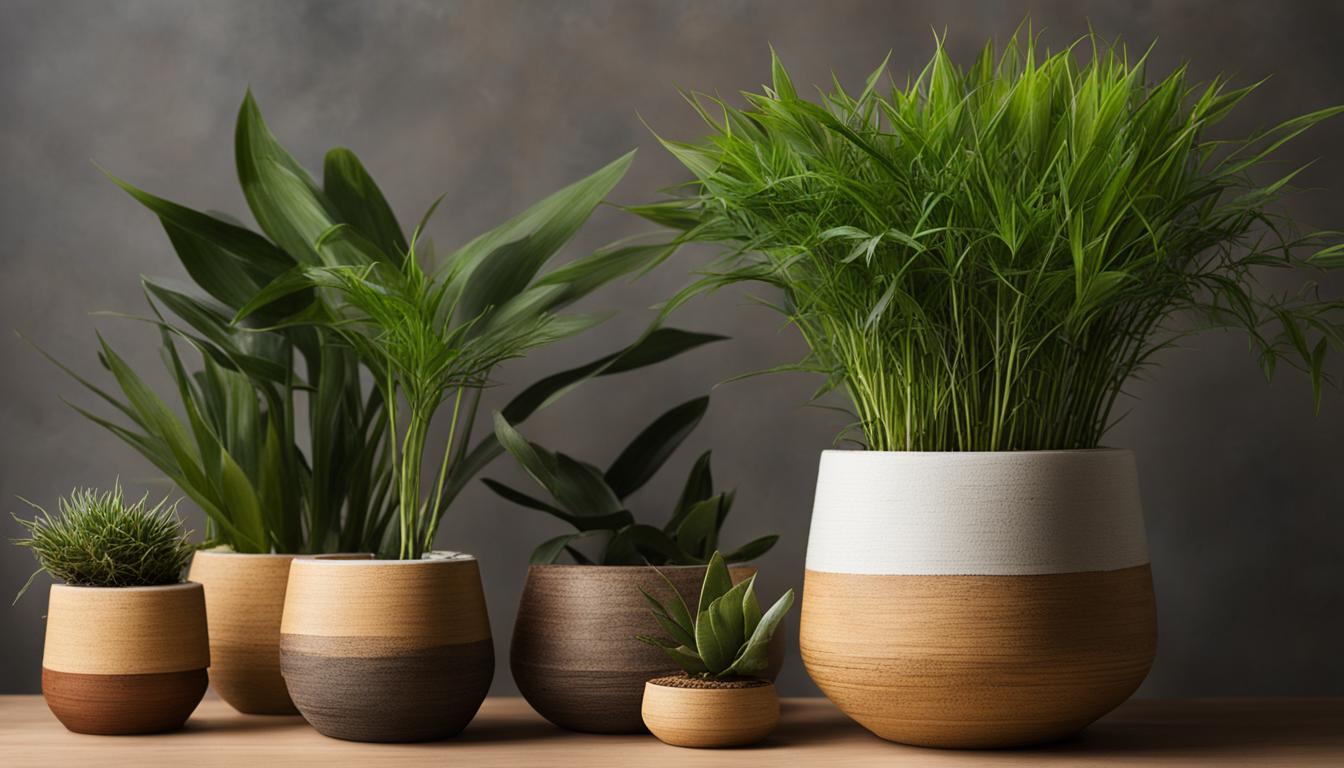
Houseplants have become a popular addition to our homes, not only for their aesthetic appeal but also for their positive impact on our mental well-being.
It’s crucial to consider the eco-friendliness of our indoor plant care practices. By adopting sustainable techniques, we can ensure that our green companions thrive while minimizing our environmental footprint.
Key Takeaways:
- Choosing terracotta clay pots or upcycling containers instead of plastic pots promotes sustainability.
- Opt for natural pesticides like neem oil and garlic oil spray to protect your plants and the environment.
- Reuse water by collecting rainwater and recycling water from rinsing fruits and vegetables.
- Support local businesses when purchasing plants to reduce carbon emissions and packaging waste.
- Save money and resources by propagating plants and participating in plant swaps.
Avoid Buying Plastic Pots
When it comes to eco-friendly indoor plant care, one simple step you can take is to avoid buying plastic pots. Plastic pots not only contribute to waste and pollution but also have negative impacts on the environment. Instead, opt for more sustainable alternatives such as terracotta clay pots or upcycled materials.
Terracotta clay pots are an excellent choice for indoor plants as they allow for proper water and air circulation, promoting healthy root growth. These pots are made from natural materials and can be reused for multiple plantings. Additionally, they add a rustic and earthy aesthetic to your home decor.
Another eco-friendly option is to upcycle containers you already have at home. Baskets, tins, or even old mugs can be repurposed as plant pots, as long as they have drainage holes for excess water to escape. This reduces the need for new materials and helps minimize plastic waste.
Benefits of Using Eco-Friendly Materials
Choosing eco-friendly materials for your plant pots not only benefits the environment but also enhances your overall plant care routine. By opting for clay or upcycled pots, you are reducing your carbon footprint and contributing to a more sustainable lifestyle.
These materials provide a healthier environment for your plants by allowing proper air circulation and preventing root rot caused by waterlogging.
Avoiding Plastic Waste
Plastic waste is a significant environmental concern, and by avoiding plastic pots, you are helping reduce the amount of non-biodegradable waste that ends up in landfills or water bodies.
Plastic takes hundreds of years to decompose, causing long-lasting harm to ecosystems and wildlife. By making a conscious choice to use eco-friendly materials, you are taking a step towards a greener future.
| Advantages of Eco-Friendly Materials | Disadvantages of Plastic Pots |
|---|---|
| Allows proper water and air circulation | Contributes to plastic waste |
| Can be reused for multiple plantings | Takes hundreds of years to decompose |
| Enhances the aesthetics of your space | Causes harm to ecosystems and wildlife |
Use Natural Pesticides
When it comes to dealing with pests on your indoor plants, it’s important to prioritize the health and safety of both yourself and your green companions.
Instead of resorting to toxic pesticides, consider using natural alternatives like neem oil and garlic oil spray. These natural pesticides are effective in controlling common pests while remaining environmentally friendly.
Neem oil, derived from the seeds of the neem tree, has insecticidal properties that can disrupt the life cycle of pests without harming beneficial insects. It works by suffocating and repelling pests such as aphids, mealybugs, and spider mites.
To use neem oil, dilute it according to the instructions and spray it on affected plants, making sure to cover both the upper and lower leaf surfaces.
Garlic oil spray is another natural pesticide that can be easily made at home. Simply crush a few cloves of garlic and mix them with water.
Let the mixture sit for a few hours, strain it, and then spray it on your plants. The strong odor of garlic acts as a repellent for pests, keeping them away from your precious foliage.
Benefits of Using Natural Pesticides
Using natural pesticides like neem oil and garlic oil spray offers several benefits. Firstly, these natural alternatives are safe to use around children, pets, and beneficial insects, as they do not contain harmful chemicals. They also break down more quickly in the environment, minimizing the risk of long-term contamination.
Furthermore, natural pesticides are readily available and often cost-effective. They can be easily found in garden centers or can be made at home using commonly available ingredients. This not only saves you money but also reduces your reliance on chemical-based products, contributing to a more sustainable approach to plant care.
| Pest | Neem Oil | Garlic Oil Spray |
|---|---|---|
| Aphids | Yes | Yes |
| Mealybugs | Yes | Yes |
| Spider Mites | Yes | No |
| Whiteflies | Yes | No |
By incorporating natural pesticides into your indoor plant care routine, you can effectively manage pest infestations while prioritizing the health and well-being of your plants and the environment. Remember to always follow the instructions provided with the products and monitor your plants closely for any signs of improvement or further pest damage.
Reuse Your Water
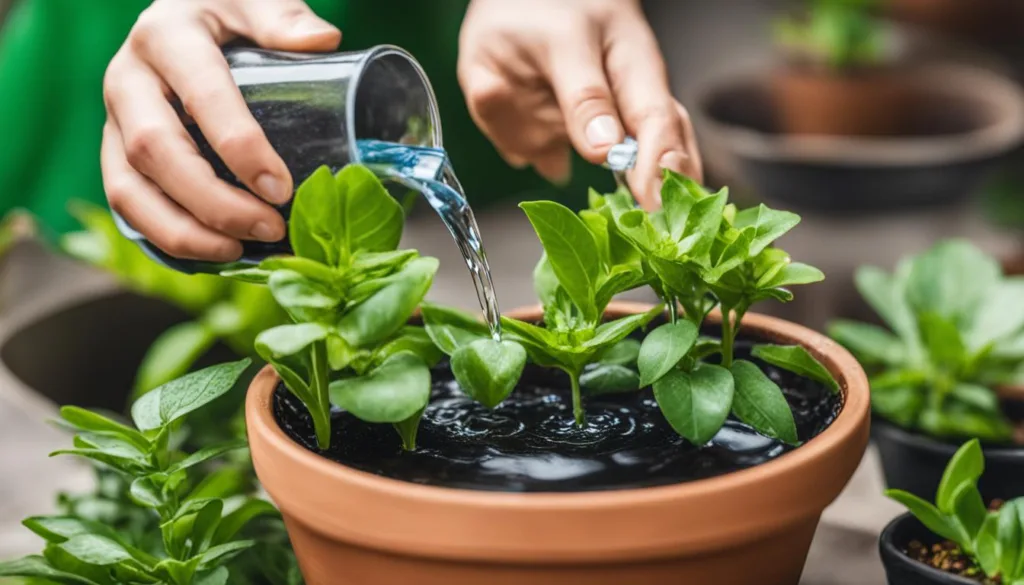
When it comes to caring for your indoor plants, reusing water is an eco-friendly practice that can benefit both your plants and the environment. One simple way to do this is by catching rainwater.
Set up buckets or containers near your home’s downspouts to collect rainwater during showers. This natural resource is chemical-free and can be used to water your plants, reducing your reliance on tap water.
Another way to reuse water is by recycling the water you use in your daily activities. For example, when you rinse fruits and vegetables, collect the water that would typically go down the drain.
This water can be poured into your watering can or directly onto your plants. By reusing this water, you are reducing water waste and ensuring that every drop counts.
Comparison of Water Sources for Indoor Plants
| Water Source | Benefits | Considerations |
|---|---|---|
| Rainwater | Natural, chemical-free | Dependent on rainfall |
| Recycled Water | Reduces water waste | Avoid using soapy or contaminated water |
| Tap Water | Convenient and readily available | May contain chemicals such as chlorine |
By reusing water for your indoor plants, you are taking a sustainable approach to plant care. Not only are you conserving water, but you are also minimizing your environmental impact.
So, the next time it rains or you have water from daily activities, don’t let it go to waste. Give your plants a drink while being mindful of the planet.
Buy Locally
When it comes to purchasing indoor plants, buying locally is not only beneficial for the environment but also supports small businesses in your community. By opting to buy locally grown plants, you can reduce packaging waste, cut carbon emissions, and contribute to a more sustainable plant care practice.
When you buy plants from local sources, you are eliminating the need for long-distance transportation, which can have a significant environmental impact.
Purchasing plants directly from greenhouses or plant shops often means that the plants are grown using more sustainable methods, such as organic or low-impact farming practices. This ensures that you are not only getting a healthy plant but also supporting growers who prioritize the well-being of the environment.
Furthermore, buying locally allows you to have a closer connection to the plants you bring into your home. You can learn more about their origins, care requirements, and even get personalized advice from knowledgeable staff.
Also, by supporting local businesses, you are contributing to the economic growth of your community and helping create a more vibrant and sustainable local plant industry.
Benefits of Buying Locally:
- Reduces packaging waste
- Cuts carbon emissions
- Supports small businesses
- Promotes sustainable plant care
- Provides closer connection to the plants
Buying locally is a win-win situation for both the environment and your community. So next time you’re in the market for a new indoor plant, consider visiting your local greenhouse or plant shop and embark on a more sustainable plant care journey.
Propagate
Propagating plants is a cost-effective and sustainable way to expand your plant collection. Not only does it save you money, but it also reduces packaging waste that comes from buying new plants. By propagating plants like ivy, monsteras, and pothos, you can create new plants from clippings of your existing ones.
To propagate plants, start by selecting a healthy and mature plant with stems that can be cut. Using a clean pair of scissors, cut a section of the stem just below a leaf node.
Remove the lower leaves from the stem, leaving only a few at the top. Place the stem in a jar of water or a pot filled with moist soil, making sure that the node is submerged or covered. Over time, roots will develop, and a new plant will start to grow.
Plant swaps are another great way to acquire new plants through propagation. You can trade clippings from your favorite plants with friends, allowing both parties to expand their collections without spending extra money.
Not only does this promote a sense of community among plant enthusiasts, but it also encourages sustainable plant care practices by reducing the need for new plant purchases.
Benefits of propagation:
- Save money on buying new plants
- Reuse pots and containers
- Grow your plant collection sustainably
- Participate in plant swaps for variety
By propagating plants and participating in plant swaps, you can enjoy the benefits of a diverse plant collection while minimizing your environmental impact.
Promote the Longevity of Your Plants
To ensure the longevity of your plants, it’s important to properly care for them. By following these tips, you can promote the health and growth of your indoor plants.
Proper Watering Techniques
One of the most crucial aspects of plant care is proper watering. Overwatering or underwatering can have detrimental effects on your plants. To prevent overwatering, make sure to check the moisture level of the soil before watering.
Stick your finger about an inch deep into the soil – if it feels damp, hold off on watering. On the other hand, if the soil feels dry, it’s time to water your plants.
When watering, make sure to provide enough water to thoroughly saturate the soil. Allow excess water to drain out from the drainage holes to avoid waterlogged roots. Remember, different plants have different water needs, so it’s important to research the specific watering requirements for each of your plants.
Preventing Overwatering
Overwatering can lead to root rot and other plant diseases. To prevent overwatering, ensure that your pots have proper drainage holes to allow excess water to escape.
You can also use a moisture meter to monitor the moisture levels of the soil. These devices can provide accurate readings and help you determine when to water your plants.
Additionally, pay attention to the signs that your plant may be getting too much water. Yellowing leaves, mushy stems, and a foul smell from the soil are all indicators of overwatering. If you notice these signs, adjust your watering routine accordingly.
Preventing Underwatering
Underwatering can cause stress and dehydration in your plants. To prevent underwatering, regularly check the moisture level of the soil and adjust your watering schedule as needed. Dry and brittle leaves, as well as drooping or wilting plants, are signs that your plants need more water.
Consider misting the leaves of your plants to increase humidity and prevent excessive moisture loss. Placing a tray of water near your plants can also help maintain a humid environment.
| Signs of Overwatering | Signs of Underwatering |
|---|---|
| Yellowing leaves | Dry and brittle leaves |
| Mushy stems | Drooping or wilting plants |
| Foul smell from the soil | Leaf edges turning brown and crispy |
By following these watering guidelines and paying close attention to the needs of your plants, you can ensure their longevity and create a thriving indoor garden
Buy Secondhand
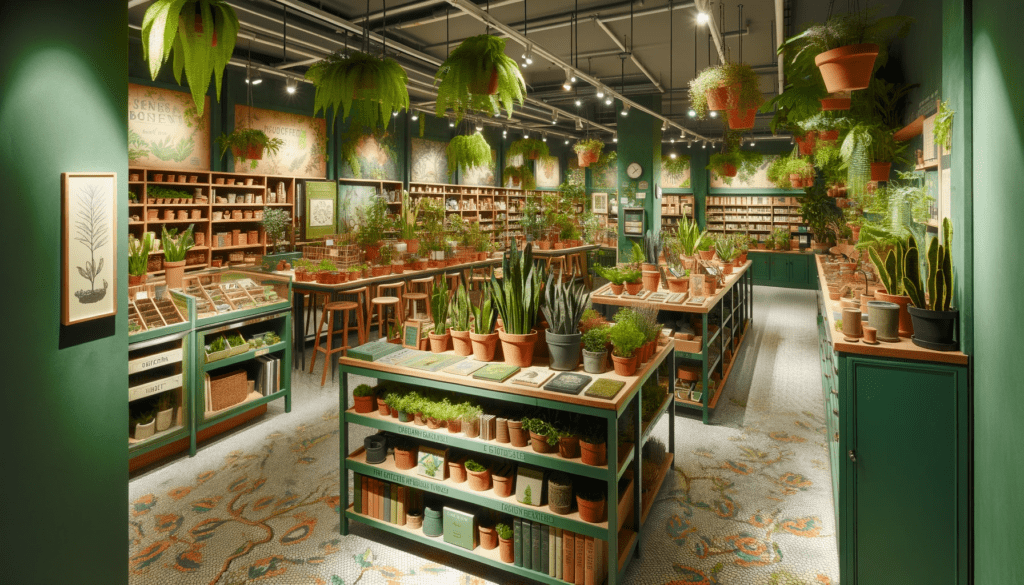
When it comes to sustainable plant parenting, buying secondhand is a fantastic option. Not only does it help reduce waste, but it also allows you to find unique and affordable items for your indoor plants.
Thrift stores and flea markets are treasure troves for finding secondhand plant pots, plant stands, watering cans, and other accessories.
By shopping secondhand, you can give new life to pre-loved items while supporting a more sustainable approach to plant care. Reusing planters and other gardening essentials reduces the demand for new manufacturing, which in turn conserves resources and minimizes carbon emissions.
So, the next time you’re looking to expand your plant collection or add some character to your indoor garden, consider visiting local thrift stores or exploring online secondhand marketplaces.
Not only will you find great deals, but you’ll also contribute to a more sustainable and environmentally friendly approach to plant parenting.
Benefits of Buying Secondhand for Plant Care:
- Reduces waste and supports sustainability
- Allows for unique and affordable finds
- Minimizes the demand for new manufacturing
- Contributes to a more eco-friendly plant parenting approach
Go Peat-Free
If you’re looking for an eco-friendly option for your indoor plants, consider going peat-free when it comes to your potting mix. Peat harvesting has significant environmental consequences, including the release of carbon dioxide and the destruction of important habitats. By choosing peat-free potting mixes, you can make a positive impact on the planet.
Instead of peat, look for potting mixes made from sustainable materials like coconut husks. These alternatives provide the necessary nutrients for your plants while reducing the demand for peat. Coconut husks are a renewable resource and using them as a potting mix helps support sustainable plant care practices.
Not only are peat-free potting mixes better for the environment, but they also have other benefits. They promote better water retention and drainage, ensuring that your plants receive the correct amount of moisture. Additionally, peat-free mixes are often less compact, allowing for better root development and overall plant health.
So, when it comes to caring for your indoor plants, make the choice to go peat-free. By opting for sustainable potting mixes made from coconut husks or other eco-friendly materials, you can contribute to a healthier planet while enjoying the beauty and benefits of your indoor plants.
FAQ
What are eco-friendly indoor plant care techniques?
Eco-friendly indoor plant care techniques refer to practices that are sustainable and environmentally friendly. These techniques include using eco-friendly pots, natural pesticides, reusing water, buying locally, propagating plants, promoting plant longevity, buying secondhand, and using peat-free potting mixes.
Why should I avoid buying plastic pots?
Plastic pots contribute to plastic waste and are not environmentally friendly. Instead, opt for more eco-friendly alternatives such as terracotta clay pots or upcycled containers with drainage holes. These options promote sustainable plant care and reduce plastic waste.
Are there natural alternatives to toxic pesticides?
Yes, there are natural alternatives to toxic pesticides. Neem oil and garlic oil spray are effective and safer options that do not contain harmful chemicals. These natural pesticides are better for both you and your plants.
How can I reuse water for my indoor plants?
Collect rainwater in buckets to use for watering your indoor plants. Rainwater is a chemical-free natural resource that can help conserve water. Another way to reuse water is by recycling the water you used to rinse your fruits and vegetables. This reduces water waste and provides a sustainable water source for your plants.
Why should I buy plants locally?
Buying plants locally supports small businesses and reduces the carbon footprint associated with long-distance transportation. It also helps reduce packaging waste, as plants can be purchased directly from the greenhouse or plant shop.
How can I propagate plants?
Propagating plants is a cost-effective and sustainable way to expand your plant collection. Plants like ivy, monsteras, and pothos can be propagated by taking clippings and propagating them in water or soil. This saves money, reduces packaging waste, and can also be done through plant swaps with friends.
What should I do to promote the longevity of my plants?
To promote the longevity of your plants, pay attention to their watering needs and avoid overwatering or underwatering. Yellowing leaves may indicate overwatering, while brown and crunchy leaves may indicate underwatering. By providing the right amount of water and proper care, your plants can thrive and avoid the need for frequent replacements.
Why should I buy secondhand for my plants?
Buying secondhand for your plants not only saves money but also reduces waste and supports sustainable plant parenting. Look for plant pots, watering cans, plant stands, or grow lights at thrift stores or flea markets. These items can be reused, reducing the need for new purchases.
What are peat-free potting mixes?
Peat-free potting mixes are alternatives to traditional potting mixes that contain peat. Choosing peat-free options helps maintain a healthy planet while caring for your indoor plants. Look for potting mixes made from coconut husks or other sustainable materials, as these still provide the necessary nutrients for your plants without contributing to the depletion of peat supplies.

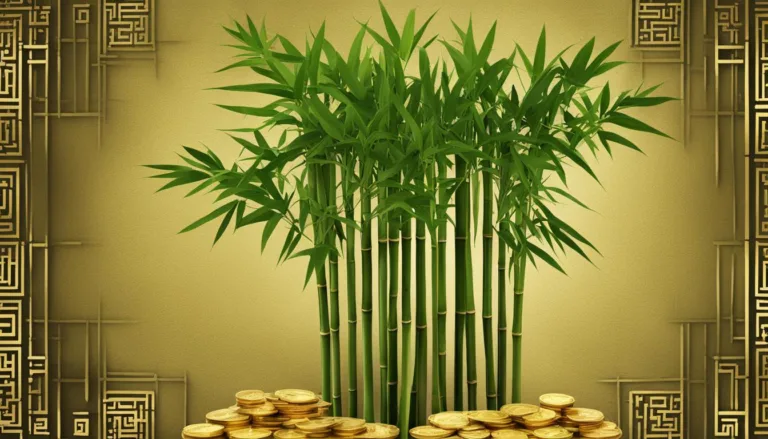
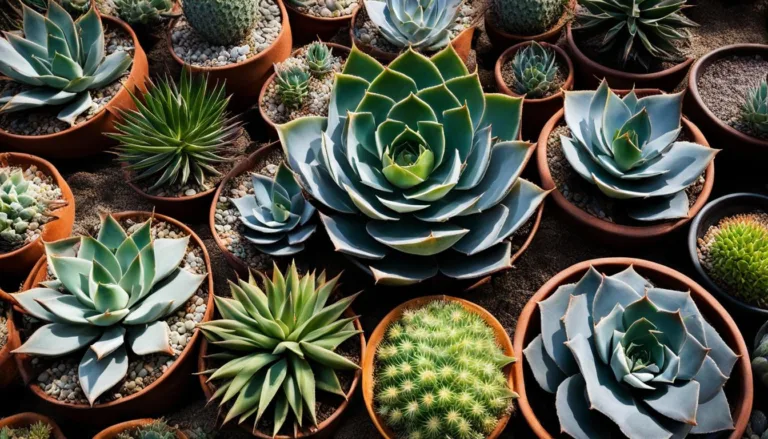
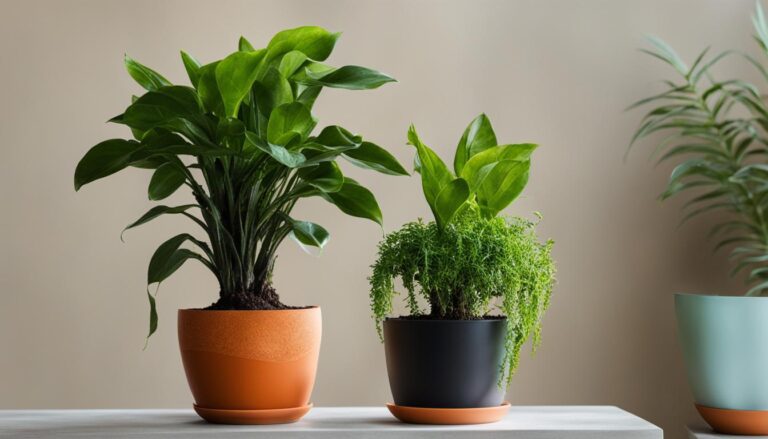
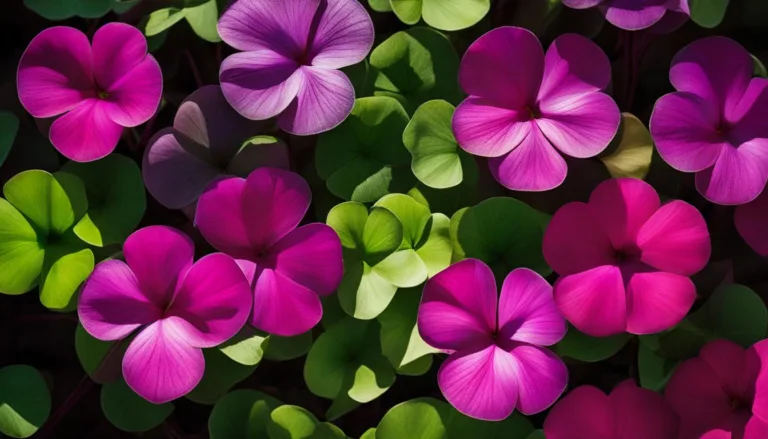
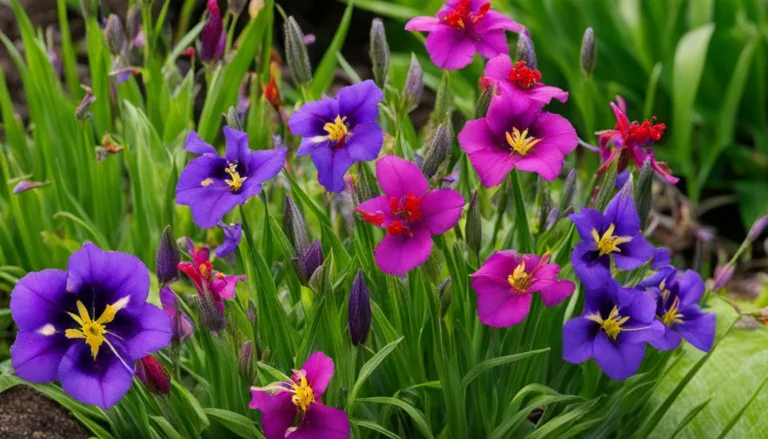
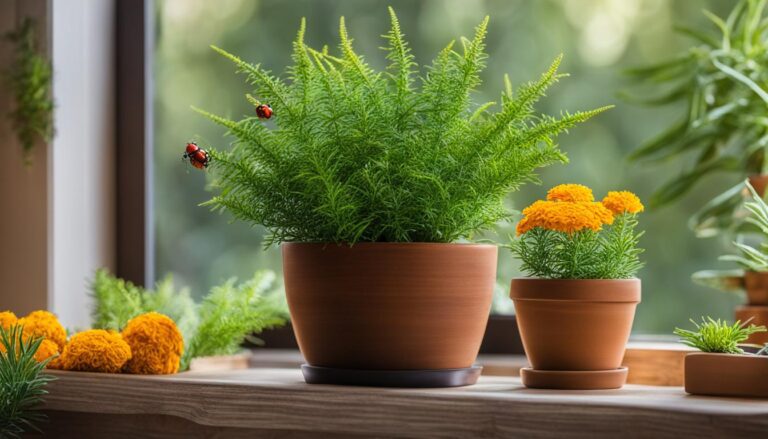
One Comment
Comments are closed.